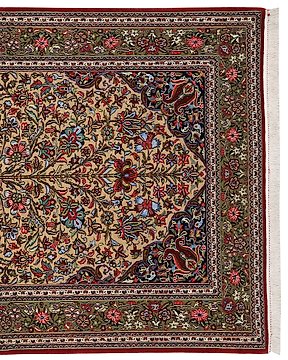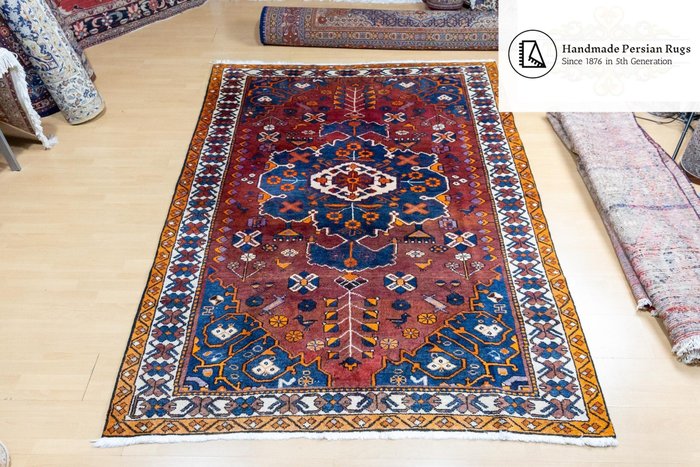
庫姆生命之樹 - 地毯 - 217 cm - 150 cm
編號 82414999

編號 82414999

Origin: Iran Shiraz Qashghai Persian carpet nomads
Knot density: approx. 120000 knots/sqm
Condition: like new (see photos)
Pattern: floral with medallion
Material: pile 100% virgin wool - warp 100% cotton from the Zagros mountains
QASHQAI Persian carpets
Location: The Qashqai nomads come from the province Fars in the southwest of Iran. They move once or twice a year, near the Persian Gulf in winter and in the Zagros Mountains in summer (because it's cooler there).
The design: Qashqa'i rugs tend to be richer in color, with red, brown, or burgundy as the primary color. The patterns are woven entirely from memory, inspired by things encountered on their travels, wildlife and nature.
You will see many animals, birds and trees on Qashqa'i carpets. They are often made of 100% wool to make them easier to roll up and transport by the nomads.
Some examples not listed here are Loribaft, Lori, Farahan, Mir, Koliai, Sultanabad, Yalameh and Sarouk.
Around Shiraz there was a powerful dynasty, the Achaemenid Empire, whose magnificent and costly monuments can still be seen in the ruins of Persepolis.
Throughout history was Shiraz famous for its beautiful gardens. The city is also known as "the city of roses". In the 13th and 14th centuries, two famous poets lived in this city, namely Hafez and Saadi, originally from Shiraz came from and are also buried there. The “Vakil” Bazaar, the largest bazaar in Iran, is considered the heart of Shiraz. In this bazaar there is, among other things, the weaving art of the “Fars” people.
In Shiraz and the rural areas around the city there are many weavers who are mostly nomadic and often weave carpets. The horizontal looms are also often used in the villages.
The light-colored, soft wool, which comes from domestic animals in Fars province, is often used for warp and carpet weaves. The design and patterns of Shiraz rugs reflect the traditions and tribal customs, meaning each rug has a different pattern depending on the tribe in which it is woven. For further explanation we should look at the Qashqa'i, Khamse and Lor carpets. Around Shiraz live some Lor tribes like “Mamasani”, “Kujilu” and “Holoku”. The rugs woven in these tribes have simple designs and no set patterns, but are often woven from inspiration. Diamond-shaped medallions are often seen in rows, and some sections feature hook-like designs, a feature of Qashqa'i rugs. The city workshops have illustrated carpets associated with the ancient ruins of Persepolis. These illustrated rugs are very subtle and are often made for national markets.
There are many rugs that feature a traditional medallion pattern with many curves and precise schemes. The precise cut and the composition of the colors as well as the effect of the colors show the relationship between the current traditional art of the nomadic tribes. The color composition often includes bright red, pure white and some dark colors for the background. Nowadays, most of the dyes are made from plant sources, which has been achieved by acknowledging and restoring the dyeing methods of the past.
The very fine and detailed Shiraz carpets are often referred to as "Mecca" carpets. This name commemorates the people who went out on Hajj and asked the weavers to make them valuable carpets to dedicate to the holy mosque in Mecca. Nowadays, however, the “Shiraz Mecca” carpet is a unique brand. The most important manufacturers in the Shiraz region and the surrounding area include “Arsanjan”, “Marvdasht”, “Kamin”, “Karbal” and “Sarvestan”.
Qashqa'i tribes
In the Qashqa'i culture, the nomadic way of life is common and tribal identity plays an important role, so the Qashqa'i still live according to the nomadic way of life and wear traditional clothes.
Sheep farming is the main source of income for these tribes; they own some sheep species that are resistant to difficult weather conditions and well adapted to the environment.
The Qashqa'i tents are made of black wool and have several functions: in winter they put them on high stands separated by small rocks and fasten them to some walls. In summer they open one side of the tent, which is decorated with small colorful tags and tufts. The furniture is located at the very end of the tent and resembles a pillar surrounded by colorful rugs. In summer you can see a loom placed horizontally in the tent, which is common among nomads. The Qashqa'i people have a long history of weaving, and women's weaving proficiency was documented in many sources in the 10th century pursued another job during the winter. The best sorts of wool were used to weave the carpets, the wool was collected in the spring and sometimes camel or goat hair was added to it. In the priceless patterns, red-dyed silk is used as the weft, and cotton yarn was rarely used to toughen the end edges of the rugs.
"Errors and errors excepted"